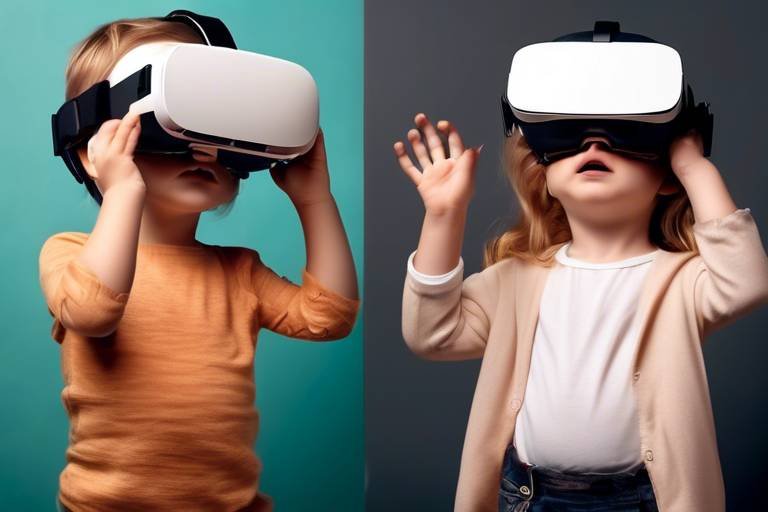The Effects of Social Media on Civic Participation
This article explores how social media influences civic engagement, including its benefits and drawbacks, and examines its role in fostering political awareness and community involvement.
Social media platforms have transformed the way individuals engage with civic activities, providing new opportunities for participation and communication among citizens and organizations. Gone are the days when civic engagement was limited to town hall meetings and paper flyers. Now, platforms like Facebook, Twitter, and Instagram serve as bustling hubs for discussion and mobilization. Imagine a world where a single tweet can rally thousands of people to a cause—this is the power of social media. With just a few clicks, individuals can share information, organize events, and connect with others who share similar interests. This shift has not only democratized the flow of information but has also made civic participation more accessible than ever before. Whether it's a local community issue or a global movement, social media allows voices to be heard, creating a vibrant tapestry of civic engagement.
Social media serves as a significant source of information, shaping public opinion and increasing political awareness among users, particularly younger demographics who rely heavily on digital platforms for news. In today's fast-paced world, where attention spans are short, social media provides bite-sized pieces of information that are easily digestible. Think of it as a buffet of news—users can sample various topics, from local elections to global crises, all at their fingertips. This accessibility can lead to a more informed citizenry, as users can follow political figures, organizations, and movements directly. However, it also raises questions about the quality of information consumed. Are users critically evaluating the sources of their news? This is where the conversation about media literacy becomes crucial, as navigating the complex landscape of social media requires discernment and critical thinking.
Social media campaigns can effectively mobilize individuals for social causes, creating a sense of community and urgency that drives collective action and participation in civic events. When individuals see friends and family advocating for a cause, it creates a ripple effect—one that can lead to significant turnout for protests, fundraisers, or awareness campaigns. For instance, movements like #MeToo and Black Lives Matter have harnessed the power of social media to galvanize support and foster a sense of belonging among participants. This digital solidarity can be incredibly powerful, as it not only amplifies voices that might otherwise go unheard but also encourages individuals to take action in their communities.
Examining successful social media campaigns can provide insights into effective strategies for mobilizing public support and fostering civic engagement in various contexts. A notable example is the Ice Bucket Challenge, which went viral on platforms like Facebook and Instagram. This campaign not only raised awareness about ALS but also generated millions in donations. By combining a fun challenge with a serious cause, it captured the attention of users and encouraged widespread participation. Another example is the March for Our Lives movement, which mobilized students and activists to advocate for gun control following tragic school shootings. These campaigns illustrate the potential of social media to create meaningful change and engage citizens in civic matters.
Despite its potential, mobilization through social media faces challenges, including misinformation, digital fatigue, and the difficulty of sustaining long-term engagement beyond initial campaigns. While the initial buzz of a campaign can attract attention, keeping that momentum going is another story. Digital fatigue, where users become overwhelmed by the constant influx of information, can lead to disengagement. Additionally, misinformation can derail efforts, as false narratives spread just as quickly as factual ones. It's essential for organizations and activists to not only mobilize support but also ensure that the information shared is accurate and constructive.
The role of social media in encouraging political participation is significant, as it facilitates discussions, promotes events, and encourages users to vote and engage with political processes. Social media acts as a digital town square, where users can debate issues, share opinions, and rally support for candidates. This increased interaction can lead to higher voter turnout, as individuals feel more connected to the political process. However, it also raises concerns about the quality of discourse. Are discussions respectful and constructive, or do they devolve into arguments? The challenge lies in fostering an environment where diverse opinions can coexist and lead to informed decision-making.
While social media can enhance civic participation, it can also lead to polarization and misinformation, creating barriers to constructive dialogue and informed decision-making. The very platforms that connect us can also divide us, as individuals retreat into echo chambers where their beliefs are reinforced rather than challenged. This polarization can hinder progress and make it difficult to find common ground on civic issues.
Social media often reinforces existing beliefs, leading to echo chambers that can polarize communities and hinder open discussions about civic issues and policies. When users only engage with like-minded individuals, it creates a skewed perception of reality. This phenomenon can be likened to living in a bubble—where one’s views are constantly validated, but the opportunity for growth and understanding is stifled. Breaking down these echo chambers is crucial for fostering healthy civic discourse and collaboration.
The spread of misinformation on social media can undermine informed civic participation, as citizens may base their decisions on false or misleading information, affecting democratic processes. In a world where “fake news” is a common term, discerning fact from fiction is more important than ever. The consequences of misinformation can be dire, leading to misguided policies and eroded trust in institutions. It’s essential for users to cultivate critical thinking skills and seek out reliable sources of information.
As social media continues to evolve, its impact on civic participation will likely change, necessitating ongoing research to understand emerging trends and their implications for democracy and community engagement. The future may hold new platforms and technologies that further transform how individuals engage with civic issues. Staying informed and adaptable will be key for citizens and organizations alike as they navigate this ever-changing landscape.
- How does social media influence civic participation?
Social media provides platforms for communication, mobilization, and information sharing, making civic engagement more accessible and widespread. - What are the benefits of using social media for civic engagement?
Benefits include increased political awareness, community building, and the ability to mobilize support for social causes quickly. - What challenges does social media pose to civic engagement?
Challenges include misinformation, digital fatigue, and the risk of polarization, which can hinder constructive dialogue. - How can individuals combat misinformation on social media?
Individuals can verify information through credible sources, engage in critical thinking, and promote media literacy within their communities.

The Rise of Social Media in Civic Engagement
Social media has become a powerful force in shaping how we connect with one another and engage in civic activities. Gone are the days when community involvement was limited to town hall meetings and local gatherings. Today, platforms like Facebook, Twitter, and Instagram have revolutionized the way individuals participate in civic life, offering unprecedented opportunities for communication and collaboration among citizens and organizations. It's almost like having a megaphone that reaches not just your neighborhood but the entire world!
One of the most significant changes brought about by social media is the ease of access to information. With just a few clicks, users can find out about local events, political campaigns, and social justice movements. This has democratized information dissemination, allowing anyone with an internet connection to be informed and engaged. Think of it as a digital town square where ideas can be shared and discussed in real-time, creating a vibrant atmosphere for civic participation.
Moreover, social media platforms have become essential tools for grassroots organizations and activists. They can rally support, organize events, and mobilize volunteers with astonishing speed and efficiency. For instance, the Ice Bucket Challenge showcased how a simple social media campaign could raise millions for ALS research while engaging people from all walks of life. This kind of viral engagement illustrates how social media can amplify voices and causes that might otherwise go unheard.
However, it's important to recognize that while social media offers these incredible opportunities, it also presents challenges. The sheer volume of information can be overwhelming, leading to what some call "digital fatigue." Users may find it difficult to sift through the noise to find meaningful content. Additionally, the rapid spread of information can sometimes lead to misinformation, which can undermine the very civic engagement that social media seeks to promote.
In summary, the rise of social media in civic engagement has transformed the landscape of how we participate in our communities. It has created new avenues for communication, mobilization, and awareness, making civic participation more accessible than ever. As we navigate this digital age, it's crucial to harness the potential of social media while remaining vigilant about its pitfalls. After all, in this interconnected world, every like, share, and tweet can spark a movement or ignite a conversation that shapes our society.

Impact on Political Awareness
In the digital age, social media has emerged as a powerful tool that profoundly influences political awareness. It acts as a double-edged sword, offering both opportunities and challenges for users navigating the political landscape. For many, especially the younger generation, platforms like Twitter, Facebook, and Instagram have become the primary sources of news and information. This shift has transformed how individuals consume political content, making it more accessible and immediate than ever before.
Consider this: in the past, staying informed about political issues required sifting through newspapers or tuning into news broadcasts at specific times. Now, with just a few taps on a smartphone, anyone can access a plethora of information from various sources. This immediacy can be exhilarating, but it also raises questions about the quality of information being consumed. Are we truly becoming more informed, or are we merely overwhelmed by the sheer volume of content available?
Moreover, social media platforms have democratized the flow of information, allowing individuals to share their thoughts and opinions with a global audience. This shift has led to a more engaged citizenry, where discussions about civic issues can occur in real-time. However, the challenge remains in discerning credible sources from unreliable ones. Users often find themselves in a maze of information, where sensational headlines can overshadow factual reporting.
To better understand the impact of social media on political awareness, let’s look at some key benefits:
- Increased Accessibility: Information is available at the fingertips of millions, breaking down barriers that once existed in traditional media.
- Real-Time Updates: Events unfold rapidly, and social media provides instant updates, keeping users informed about political developments as they happen.
- Diverse Perspectives: Users can access a variety of viewpoints, which can broaden their understanding of complex political issues.
However, it’s essential to recognize the darker side of this phenomenon. The same platforms that foster awareness can also contribute to misinformation and confusion. The rapid spread of fake news can skew public perceptions and lead to misinformed decisions. For instance, studies have shown that sensationalized stories often receive more engagement than factual reporting, creating an environment where misinformation thrives.
As we navigate this complex landscape, it’s crucial to cultivate media literacy among users. By equipping individuals with the skills to critically evaluate sources and discern fact from fiction, we can enhance the positive impact of social media on political awareness. Educational initiatives aimed at improving media literacy can empower citizens to engage thoughtfully with the information they encounter online.
In conclusion, while social media undeniably plays a pivotal role in shaping political awareness, it is essential to approach it with a critical eye. The potential for increased engagement and informed decision-making exists, but it requires a collective effort to combat misinformation and promote credible sources. As we continue to embrace this digital age, the challenge lies in ensuring that social media serves as a conduit for genuine political awareness rather than a breeding ground for confusion.

Mobilization for Social Causes
In today's digital age, social media has become a powerful tool for mobilizing individuals around social causes. The ability to share information instantly and reach vast audiences has transformed how grassroots movements are organized and executed. Social media platforms like Facebook, Twitter, and Instagram allow activists to create awareness, gather support, and encourage participation in a way that was previously unimaginable. Imagine a world where a single tweet can spark a global movement; that's the reality we live in now.
One of the most compelling aspects of social media mobilization is its capacity to create a sense of community. When individuals see others sharing their passion for a cause, it fosters a feeling of belonging and urgency. Whether it’s a hashtag campaign or a viral video, these digital interactions can ignite a collective spirit that drives people to take action. For instance, movements such as #BlackLivesMatter and #MeToo have not only highlighted critical social issues but have also galvanized millions of people to participate in protests, discussions, and advocacy efforts.
However, the effectiveness of social media in mobilizing individuals for social causes can often be attributed to specific strategies that resonate with users. Here are some key elements that contribute to successful mobilization:
- Emotional Appeal: Content that evokes strong emotions—whether it’s joy, anger, or sadness—tends to be shared more widely, increasing visibility.
- Clear Calls to Action: Posts that clearly outline what individuals can do, such as attending a rally or signing a petition, are more likely to drive engagement.
- Visual Content: Images and videos are more engaging than text alone, making them crucial for capturing attention and conveying messages quickly.
Moreover, social media allows for real-time updates and feedback, which can enhance the mobilization process. Organizers can share live updates about events, provide logistical information, and even respond to participants’ questions instantly. This level of interaction not only keeps the momentum going but also builds trust and transparency within the community.
As we look at various case studies of successful social media campaigns, it becomes evident that the combination of strategic messaging and community engagement plays a vital role. For example, the Ice Bucket Challenge raised over $115 million for ALS research through a simple yet effective call to action that encouraged participants to film themselves pouring ice water over their heads and challenge others to do the same. This campaign not only spread awareness but also fostered a sense of fun and camaraderie among participants.
However, it’s essential to recognize that mobilization through social media isn't without its challenges. While it can create a surge of support for a cause, sustaining that engagement over time can be difficult. Often, the initial excitement fades, leading to what’s known as “digital fatigue.” This phenomenon occurs when individuals feel overwhelmed by the constant barrage of information and calls to action, resulting in disengagement.
In conclusion, social media has revolutionized how we mobilize for social causes, creating opportunities for greater participation and awareness. Yet, as we harness its power, we must also be mindful of the challenges it presents. The future of civic engagement will depend on our ability to adapt these strategies to maintain momentum and foster genuine community involvement.
1. How can I get involved in social media campaigns for social causes?
You can start by following organizations that align with your interests, sharing their posts, and participating in online events or discussions they host.
2. What are some effective ways to spread awareness on social media?
Utilizing hashtags, creating engaging visual content, and sharing personal stories related to the cause can help spread awareness effectively.
3. How do I ensure the information I share is accurate?
Always verify information from reliable sources before sharing. Fact-checking websites can help you identify misinformation.

Case Studies of Successful Campaigns
When we think about the power of social media, it’s hard not to be amazed by the impact it has had on civic participation. One of the best ways to understand this influence is through case studies of successful campaigns that have harnessed the power of platforms like Facebook, Twitter, and Instagram. For instance, the #BlackLivesMatter movement is a prime example of how social media can galvanize individuals and communities around a cause. Launched in 2013, it used social media to raise awareness about racial injustice and police brutality, leading to widespread protests and discussions about systemic racism.
Another notable campaign is the Ice Bucket Challenge, which went viral in 2014. This campaign aimed to raise awareness and funds for ALS research. Participants would dump a bucket of ice water over their heads and challenge others to do the same, all while sharing their videos on social media. The campaign not only raised millions of dollars but also educated countless individuals about ALS, showcasing how a simple idea can lead to significant civic engagement and awareness.
These campaigns highlight several key strategies that contribute to their success:
- Emotional Appeal: Successful campaigns often tap into strong emotions, whether it’s anger, joy, or empathy, to engage users.
- Shareability: Creating content that is easy to share encourages users to spread the message further, amplifying the campaign's reach.
- Community Building: Campaigns that foster a sense of belonging or community can motivate individuals to participate actively and support one another.
Moreover, the March for Our Lives campaign, initiated by students from Stoneman Douglas High School after a tragic shooting in 2018, effectively utilized social media to organize nationwide protests advocating for gun control. The students shared their stories and mobilized their peers through platforms like Instagram and Twitter, demonstrating how social media can empower younger demographics to take action on pressing civic issues.
However, it's essential to recognize that the success of these campaigns often hinges on the ability to maintain momentum. This can be challenging, as many social media campaigns experience a peak of engagement followed by a rapid decline in interest. To combat this, successful campaigns often implement follow-up strategies, such as ongoing education, regular updates on progress, and calls to action that encourage sustained participation.
In conclusion, the case studies of the #BlackLivesMatter movement, the Ice Bucket Challenge, and March for Our Lives illustrate the tremendous potential of social media as a tool for civic engagement. By understanding the strategies that lead to their success, we can glean valuable insights into how to effectively mobilize communities and foster meaningful dialogue around civic issues.
- What is the role of social media in civic engagement?
Social media serves as a platform for individuals to share information, mobilize support, and engage in discussions about civic issues, enhancing overall participation. - How can social media campaigns maintain long-term engagement?
Successful campaigns often focus on community building, regular updates, and ongoing education to keep participants engaged beyond initial actions. - What challenges do social media campaigns face?
Challenges include misinformation, digital fatigue, and the difficulty of sustaining interest in civic issues over time.

Challenges in Mobilization
While social media has undoubtedly revolutionized the way we mobilize for social causes, it is not without its challenges. One of the most pressing issues is the phenomenon of misinformation. In the age of rapid information exchange, it’s all too easy for false narratives to spread like wildfire. This can lead to confusion and a lack of trust among potential participants, who might hesitate to join initiatives if they are unsure about the facts surrounding a cause.
Moreover, digital fatigue is another significant barrier. With the constant barrage of notifications and updates, individuals may find themselves overwhelmed. This can result in a sense of apathy towards civic engagement. Picture this: you’re scrolling through your feed, and every other post is asking you to sign a petition or join a rally. Eventually, it all starts to blend together, and you might just tune it out altogether. This fatigue can diminish the urgency that social causes often rely on to spur action.
Additionally, sustaining long-term engagement is another hurdle. Many social media campaigns achieve a spike in participation initially, but maintaining that momentum can be challenging. People are often drawn to the excitement of a new cause but may not remain engaged once the initial fervor fades. This can lead to a situation where campaigns struggle to convert one-time participants into committed advocates. To tackle this, organizations need to develop strategies that not only attract attention but also keep individuals involved over time.
Finally, we must consider the issue of algorithmic bias. Social media platforms often prioritize content that generates engagement, which can unintentionally marginalize important but less sensational issues. This means that while some causes gain traction, others may languish in obscurity simply because they don’t fit the mold of what captures attention. Understanding how these algorithms work is crucial for organizations aiming to mobilize effectively.
In summary, while social media offers powerful tools for mobilization, it is essential to navigate these challenges thoughtfully. By addressing misinformation, combating digital fatigue, ensuring sustained engagement, and understanding algorithmic biases, organizations can harness the full potential of social media to foster civic participation.
- What is the role of social media in civic engagement? Social media provides platforms for individuals to share information, organize events, and mobilize support for various causes, enhancing civic participation.
- How can misinformation affect civic participation? Misinformation can lead to confusion and distrust, causing individuals to hesitate in participating in civic activities or supporting causes.
- What strategies can organizations use to combat digital fatigue? Organizations can focus on delivering valuable content, creating engaging narratives, and using targeted messaging to keep audiences interested and involved.
- How do algorithms influence civic engagement on social media? Algorithms can prioritize certain types of content, which may lead to important issues being overlooked if they don't generate enough engagement.

Influence on Political Participation
In today's digital age, the influence of social media on political participation cannot be overstated. It acts as a powerful tool that not only facilitates discussions but also promotes events and encourages users to engage with political processes. Imagine social media as a bustling town square where people gather to share ideas, debate issues, and rally support for causes they care about. It's a place where a single tweet or post can ignite a movement, making political engagement more accessible and dynamic than ever before.
One of the most significant ways social media impacts political participation is through its ability to inform and mobilize. Platforms like Twitter, Facebook, and Instagram serve as vital sources of information, especially for younger demographics who are increasingly turning to digital channels for news. In fact, studies have shown that a large portion of millennials and Gen Z individuals rely on social media for political updates, making it a crucial space for political discourse. This trend has led to an increase in political awareness, where users are not just passive consumers of information but active participants who share, comment, and engage in discussions that shape public opinion.
Additionally, social media has revolutionized the way political events are organized and promoted. Campaigns can now reach audiences on a global scale with just a few clicks. For instance, a local rally can gain national attention through hashtags and viral posts, encouraging individuals from various backgrounds to join in. This ability to mobilize people for political events is not just limited to major campaigns; grassroots movements have also found a voice through social media, allowing ordinary citizens to rally support for local issues that matter to them. The connection fostered by these platforms creates a sense of community and urgency, driving individuals to participate in civic events and initiatives.
However, it’s essential to recognize that the influence of social media on political participation is not without its challenges. While it encourages engagement, it can also lead to superficial interactions where users may feel involved without taking meaningful action. For example, liking a post or sharing a meme can give the illusion of participation, but it may not translate into real-world involvement such as voting or attending town hall meetings. Furthermore, the sheer volume of information can be overwhelming, leading to digital fatigue where users disengage altogether.
To illustrate the diverse influence of social media on political participation, consider the following table that outlines various platforms and their effects:
| Social Media Platform | Effect on Political Participation |
|---|---|
| Real-time updates and discussions; facilitates rapid information sharing. | |
| Event organization; community building; targeted advertising for campaigns. | |
| Visual storytelling; engagement through creative content; mobilization through influencers. | |
| TikTok | Reaches younger audiences with entertaining content; encourages viral movements. |
In conclusion, social media is a double-edged sword in the realm of political participation. It has the power to inform, mobilize, and engage, but it also presents challenges that can dilute meaningful participation. As we navigate this ever-evolving landscape, it’s crucial for individuals to harness the positive aspects of social media while remaining vigilant against its pitfalls. By doing so, we can ensure that our civic engagement is not just a series of clicks but a vibrant and active participation in our democracy.
- How does social media increase political awareness? Social media platforms provide real-time updates and discussions, making it easier for users to stay informed about political issues.
- Can social media mobilize people for political events? Yes, social media can effectively organize and promote events, allowing campaigns to reach wider audiences quickly.
- What are the challenges of political participation on social media? Challenges include digital fatigue, misinformation, and the tendency for superficial engagement rather than meaningful action.

Negative Consequences of Social Media
While social media has opened up numerous avenues for civic participation, it also harbors significant drawbacks that can undermine its positive potential. One of the most pressing issues is the phenomenon of polarization. This occurs when social media platforms create environments where users are primarily exposed to information that aligns with their existing beliefs. As a result, individuals become entrenched in their viewpoints, often leading to a lack of understanding or empathy for opposing perspectives. This echo chamber effect can stifle constructive dialogue and make it increasingly difficult for communities to engage in meaningful discussions about important civic issues.
Furthermore, the spread of misinformation on social media is another critical challenge. In a world where information travels faster than ever, false narratives can quickly gain traction, leading citizens to base their civic decisions on misleading or entirely false information. This not only affects individual decision-making but can also have broader implications for democratic processes. For instance, a table below illustrates some of the common types of misinformation encountered on social media:
| Type of Misinformation | Description |
|---|---|
| Fake News | Completely fabricated stories that are presented as news articles. |
| Misleading Headlines | Headlines that exaggerate or misrepresent the content of an article. |
| Manipulated Images | Images that have been altered to mislead viewers about the context or truth. |
| Conspiracy Theories | Unfounded theories that suggest hidden agendas behind events or situations. |
These types of misinformation can lead to confusion and distrust among citizens, making it challenging to foster an informed electorate. As people consume content that aligns with their biases, the risk of becoming misinformed increases, which can ultimately affect civic engagement. When individuals are unsure of what information to trust, they may become apathetic towards participation in civic activities, believing that their efforts won't make a difference.
Another significant negative consequence is the phenomenon of digital fatigue. As individuals are bombarded with constant notifications, updates, and calls to action on various platforms, they can become overwhelmed. This fatigue can lead to disengagement, where users simply tune out from civic discussions and activities altogether. When social media becomes a source of stress rather than a tool for empowerment, it diminishes its effectiveness as a platform for civic engagement.
In summary, while social media has the power to enhance civic participation, it also presents challenges that can hinder open dialogue and informed decision-making. The issues of polarization, misinformation, and digital fatigue are significant obstacles that need to be addressed if we are to harness the full potential of social media for civic engagement. As we navigate this complex landscape, it’s crucial to remain vigilant and proactive in promoting media literacy and encouraging critical thinking among users.
- What is the echo chamber effect?
The echo chamber effect occurs when individuals are exposed primarily to information that reinforces their existing beliefs, leading to polarization and a lack of understanding of opposing viewpoints.
- How does misinformation impact civic participation?
Misinformation can mislead citizens, affecting their decision-making and ultimately undermining democratic processes and informed civic engagement.
- What is digital fatigue?
Digital fatigue refers to the overwhelming feeling individuals experience due to constant notifications and updates, which can lead to disengagement from civic discussions and activities.

Polarization and Echo Chambers
In the vibrant world of social media, where opinions fly faster than the speed of light, one of the most concerning phenomena is the rise of polarization and the creation of echo chambers. Have you ever found yourself scrolling through your feed, only to notice that the content aligns perfectly with your beliefs? This isn’t just a coincidence; it’s a reflection of how social media algorithms curate our experiences, often leading us to engage with content that reinforces our existing views. This can create a dangerous cycle where opposing viewpoints are not just ignored but actively dismissed.
Echo chambers can be likened to digital fortresses, where people surround themselves with like-minded individuals, creating an environment that stifles diversity of thought. When we constantly engage with similar perspectives, we risk becoming entrenched in our views, making it increasingly difficult to engage in constructive dialogues with those who think differently. This phenomenon is particularly pronounced among younger users, who may be less experienced in navigating differing opinions and are more susceptible to the influences of their online communities.
Moreover, the implications of polarization extend far beyond personal interactions. It can lead to a fragmented society where collective decision-making becomes challenging. When communities are divided, finding common ground on pressing civic issues—such as climate change, healthcare, or education—becomes a Herculean task. The inability to engage in productive discussions can hinder progress and foster an environment where misinformation thrives.
To illustrate the impact of polarization, consider the following table that highlights some of the key effects it can have on civic engagement:
| Effect | Description |
|---|---|
| Reduced Dialogue | Polarization often leads to a decrease in open discussions, as individuals are less willing to engage with opposing views. |
| Increased Hostility | When communities become polarized, interactions can become hostile, further alienating individuals from one another. |
| Stunted Civic Participation | People may feel disillusioned and less inclined to participate in civic activities when they perceive their views are not represented. |
As we navigate this complex landscape of social media, it’s crucial to be aware of the potential for polarization and to actively seek out diverse perspectives. Engaging with different viewpoints not only enriches our understanding but also fosters a more inclusive civic environment. So, the next time you find yourself in a digital echo chamber, consider stepping outside its walls. After all, true civic engagement thrives in an atmosphere of open dialogue and mutual respect.
- What is an echo chamber? An echo chamber is a situation where beliefs are amplified or reinforced by communication and repetition inside a defined system, leading to a lack of exposure to differing viewpoints.
- How does polarization affect civic engagement? Polarization can lead to reduced dialogue and increased hostility, making it harder for communities to engage in constructive discussions and participate in civic activities.
- What can individuals do to combat polarization? Individuals can actively seek out diverse perspectives, engage in respectful conversations, and challenge their own beliefs to foster a more inclusive environment.

Misinformation and Its Effects
Misinformation has become a pervasive issue in the digital age, particularly on social media platforms where information spreads like wildfire. This phenomenon can significantly undermine informed civic participation. When individuals encounter false or misleading information, it can distort their understanding of critical issues, leading to misguided opinions and decisions. Imagine trying to navigate a maze blindfolded; that’s what it feels like for many citizens when they attempt to sift through the noise of misinformation to find the truth.
The effects of misinformation can be profound and far-reaching. For instance, during election cycles, false narratives can sway voters’ perceptions about candidates and policies. A study conducted by the Pew Research Center found that approximately 64% of Americans believe that misinformation has a major impact on their ability to make informed political decisions. This statistic highlights the urgent need for awareness and critical thinking skills among users.
Moreover, misinformation can contribute to a general sense of distrust in institutions. When citizens are bombarded with conflicting information, it can lead to skepticism about the media, government, and even scientific communities. This erosion of trust makes it increasingly difficult for civic leaders and organizations to engage citizens in constructive dialogue. To illustrate, consider the following table which outlines the primary sources of misinformation and their effects:
| Source of Misinformation | Effects on Civic Participation |
|---|---|
| Social Media Platforms | Spreads false narratives quickly, leading to confusion and misinformed decisions. |
| Fake News Websites | Deliberately mislead readers, fostering distrust in legitimate news sources. |
| Influencer Endorsements | Can propagate unverified claims, impacting public opinion and behavior. |
In addition to affecting political views, misinformation can also hinder community engagement. When individuals are misinformed about local issues, such as public health initiatives or community projects, they may choose not to participate, believing their efforts would be futile or misdirected. This creates a cycle of disengagement that can be hard to break. To combat this, it’s crucial for citizens to develop media literacy skills, allowing them to critically evaluate the information they encounter online.
Ultimately, the impact of misinformation on civic participation cannot be overstated. It is essential for individuals to seek out reliable sources of information and engage in discussions that challenge their perspectives. By doing so, they can contribute to a more informed and active citizenry capable of navigating the complexities of modern democracy.
- What is misinformation? Misinformation refers to false or misleading information that is spread, regardless of intent.
- How does misinformation affect civic engagement? It can distort public understanding of issues, leading to misguided opinions and decreased participation.
- What can individuals do to combat misinformation? Individuals can develop media literacy skills, verify information through reliable sources, and engage in discussions that promote critical thinking.

Future Trends in Civic Participation
As we look to the horizon, the landscape of civic participation is poised for significant transformation, largely driven by the ongoing evolution of social media. In this digital age, where information flows faster than ever, the way we engage with our communities and political systems is changing. But what does the future hold? One major trend is the increasing integration of artificial intelligence and data analytics in social media platforms. These tools can analyze user behavior and preferences, tailoring content to foster deeper engagement. This means that civic organizations could potentially reach their audiences more effectively, ensuring that important issues resonate with the right people.
Moreover, the rise of virtual and augmented reality technologies is set to revolutionize how we experience civic events. Imagine attending a town hall meeting from the comfort of your home, but feeling as if you're right there in the room with other participants. This immersive experience could not only enhance participation but also make civic activities more accessible to individuals who may face barriers in traditional settings.
Another trend to watch is the growing importance of micro-influencers in civic engagement. These are individuals with smaller, yet highly engaged followings who can sway opinions and mobilize action within their communities. Unlike traditional influencers, micro-influencers often have a more genuine connection with their audience, making their calls to action more impactful. This shift could lead to more grassroots movements gaining traction, as people turn to relatable voices rather than distant celebrities.
Furthermore, the concept of digital citizenship is becoming increasingly relevant. As more people engage with civic issues online, there's a growing need to educate users about responsible online behavior, including how to identify misinformation and engage in constructive dialogue. Educational initiatives aimed at fostering digital literacy will be crucial in ensuring that citizens are equipped to navigate the complexities of social media and civic participation.
Finally, the emergence of blockchain technology could introduce new levels of transparency and trust in civic processes. By securely recording votes and public opinions, blockchain could help mitigate concerns about fraud and manipulation, empowering citizens to participate in a more trustworthy environment. In a world where skepticism about institutions is rampant, this technology could play a pivotal role in restoring faith in democratic processes.
In summary, the future of civic participation is bright, filled with opportunities for innovation and engagement. As we embrace these changes, it’s essential to remain vigilant about the challenges that accompany them, ensuring that our digital spaces foster inclusivity and informed participation.
- What role does social media play in civic engagement?
Social media serves as a platform for information sharing, mobilization, and community building, allowing individuals to engage with civic activities more easily. - How can technology enhance civic participation?
Technological advancements such as AI, VR, and blockchain can improve access, transparency, and engagement in civic processes. - What are the risks associated with social media in civic participation?
Risks include misinformation, polarization, and the potential for echo chambers which can hinder constructive dialogue. - How can individuals ensure they are participating responsibly online?
Educating oneself about digital literacy, verifying information, and engaging respectfully with differing viewpoints can promote responsible participation.
Frequently Asked Questions
- How does social media enhance civic participation?
Social media enhances civic participation by providing platforms for individuals to connect, share information, and mobilize for causes. It allows users to engage in discussions about civic issues, organize events, and promote awareness, making it easier for people to get involved and take action.
- What are the negative impacts of social media on civic engagement?
While social media can foster engagement, it also has negative impacts such as the spread of misinformation, polarization, and the creation of echo chambers. These factors can hinder constructive dialogue and lead to misinformed decision-making among citizens.
- Can social media campaigns effectively mobilize people for social causes?
Absolutely! Social media campaigns can create a sense of community and urgency, driving collective action for social causes. They allow for quick dissemination of information and can rally support from a wide audience, leading to successful mobilization for various civic events.
- How does social media influence political awareness?
Social media plays a crucial role in shaping political awareness, especially among younger demographics. It serves as a primary source of news and information, helping users stay informed about political issues and encouraging them to engage in discussions and civic activities.
- What challenges do social media mobilization efforts face?
Mobilization efforts through social media face several challenges, including misinformation, digital fatigue, and the difficulty of maintaining long-term engagement. These hurdles can impact the effectiveness of campaigns and the sustainability of civic participation.
- What future trends can we expect in civic participation through social media?
As social media continues to evolve, we can expect new trends in civic participation, such as increased integration of technology in activism and more sophisticated ways of combating misinformation. Ongoing research will be essential to understand these changes and their implications for democracy and community engagement.



















